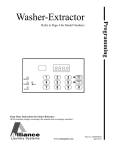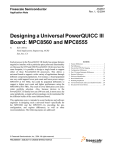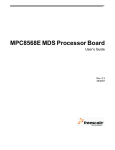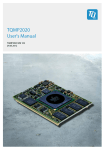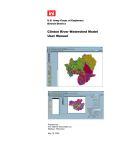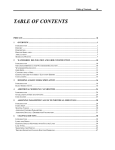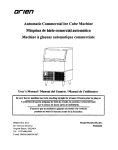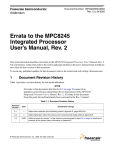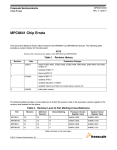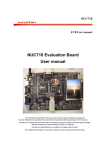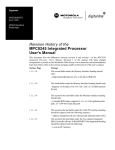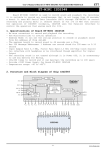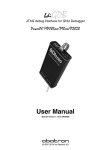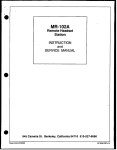Download MPC8610 Chip Errata
Transcript
MPC8610CE Rev. 0, 01/2010 Freescale Semiconductor Chip Errata MPC8610 Chip Errata This document details all known silicon errata for the MPC8610 device.The following table provides a revision history for this document. Table 1. Document Revision History Revision Date 0 01/2010 Significant Changes Initial public release Revision Level to Part Marking Cross-Reference The following table provides a cross-reference to match the revision code in the processor version register to the revision level marked on the device. Table 2. Revision Level to Part Marking Cross-Reference Part Revision MPC8610 1.1 e600 Core Revision Device Marking 2.2 B Processor Version Register Value 0x8004_0202 System Version Register Value 0x80A0_0011 Table 3 summarizes all known errata for blocks on the MPC8610 and lists the corresponding silicon revision level to which it applies. A ‘Yes’ entry indicates the erratum applies to a particular revision level, while a ‘No’ entry means it does not apply. Note Table 3. Summary of Silicon Errata and Applicable Revision Errata Name Projected Solution Silicon Rev. 1.1 DDR DDR 1 Automatic data initialization and DLL resets to DRAM are not performed correctly if CS2 and CS3 are interleaved © Freescale Semiconductor , 2009. All Rights Reserved. No plans to fix Yes Errata Name Projected Solution Silicon Rev. 1.1 DDR 2 Memory contents may not be retained during HRESET sequence No plans to fix Yes No plans to fix Yes No plans to fix Yes e600 1 Unexpected instruction fetch may occur when mtmsr/isync No plans to fix transitions MSR[IR] from 1 to 0 and isync instruction resides in unmapped page Yes e600 2 core_mcp or core_sreset signal assertion during transition to Nap may hang processor No plans to fix Yes e600 3 Unpaired stwcx. may hang processor No plans to fix Yes No plans to fix Yes 2 2 2 Enabling I C could cause I C bus freeze when other I C devices No plans to fix communicate Yes DMA DMA 1 DMA_DACK bus timing violation when operating in external DMA master mode DUART DUART 1 BREAK detection triggered multiple times for a single break assertion e600 GEN GEN 1 CPU-only reset may result in a failure in the platform logic I2C I2C 1 JTAG JTAG 1 Debug visibility unattainable without COP warm-up clock bit set during HRESET assertion No plans to fix Yes JTAG 2 Store-type operations during COP softstop debug mode may hang processor; Machine check error limitations No plans to fix Yes JTAG 3 Boundary scan test on SerDes transmitter pins needs special No plans to fix requirement incompliant to IEEE 1149.1 specification Yes eLBC eLBC1 Multi-bank DRAM and SDRAM will not work without any external No plans to fix logic Yes eLBC 2 LTEATR and LTEAR may show incorrect values under certain No plans to fix scenarios Yes eLBC 3 UPM does not have indication of completion of a Run Pattern No plans to fix special operation Yes MCM MCM 1 Unmapped tlbie EA causes local access window error No plans to fix Yes PEX 2 Completion Timeout error disable corrupts CRS threshold error No plans to fix data Yes PEX 3 No mechanism for recovery from hang after access to down link Yes PEX No plans to fix MPC8610 Chip Errata, Rev. 0, 01/2010 2 Freescale Semiconductor Errata Name Projected Solution Silicon Rev. 1.1 PEX 4 Reads to PCI Express CCSRs or local config space temporarily No plans to fix return all Fs Yes PCI PCI 1 Assertion of STOP by a target device on the last beat of a PCI No plans to fix memory write transaction can cause a hang Yes SPI SPI 1 Selection of GPIO functionality on SPISEL signal causes MME No plans to fix in SPI Yes PMON PMON 1 Some local bus events are not counted correctly in the perform- No plans to fix ance monitor Yes MPC8610 Chip Errata, Rev. 0, 01/2010 Freescale Semiconductor 3 DDR 1: Automatic data initialization and DLL resets to DRAM are not performed correctly if CS2 and CS3 are interleaved Description: CS2 and CS3 can be interleaved together by setting DDR_SDRAM_CFG[BA_INTLV_CTL] to 7'bx1xx0x0. In this mode, the DDR controller may operate incorrectly for 2 different features. First, the DDR controller will not initialize DRAM data properly if DDR_SDRAM_CFG_2[D_INIT] is set. If D_INIT is set with CS2 and CS3 interleaved together, then the memory spaced defined by CS2 and CS3 will not be initialized. Second, the DDR controller may not issue DLL reset commands to CS2 and CS3 when exiting self refresh. Note that this feature is typically enabled when DDR_SDRAM_CFG_2[DLL_RST_DIS] is cleared. If CS0 and CS1 are both disabled via CSn_CONFIG[CS_n_EN] (and CS2 and CS3 are interleaved together), then only CS3 will receive the DLL reset command when self refresh is exited. Note that neither of these issues will be present if all chip selects are enabled and CS0-CS3 are interleaved together. Impact: There are 2 results that can be observed from this erratum. If the first scenario listed above is present, then the memory space defined by CS2 and CS3 will not be initialized properly when DDR_SDRAM_CFG_2[D_INIT] is set. If the second scenario listed above is present, then the DLL reset command will not be issued as expected to CS2. It is not expected that this will cause any issues with DDR2 memories. DDR2 JEDEC specifications state that the DRAM's DLL is automatically disabled when entering self refresh, and the DLL is automatically reenabled when exiting self refresh. Although it would be possible for some vendors to vary, the DLL reset should not be required by the DRAMs when exiting self refresh. The DLL reset feature was originally added to support DDR1 memories. It appears that DDR1 memories will typically only require the DLL reset when the frequency is changed, but this scenario should still be avoided if possible to prevent any potential issues. Workaround: There are several workarounds for this erratum. The preferred workaround will be to disable interleaving between CS2 and CS3. CS0 and CS1 can still be interleaved together. In addition, CS0 and CS3 could still be interleaved together without any issues. If it is still preferred to interleave CS2 and CS3 together, then one of two workarounds can be used for initializing memory. First, software could be used to initialize memory (i.e., via the DMA) instead of using DDR_SDRAM_CFG_2[D_INIT]. In addition, the memory controller could be enabled without CS2 and CS3 interleaved while DDR_SDRAM_CFG_2[D_INIT] is set. After D_INIT is cleared by the hardware, CS2 and CS3 could then be programmed to be interleaved together (via DDR_SDRAM_CFG[BA_INTLV_CTL]). The memory space defined by the CS2_BNDS register would then need to be updated to include the entire memory space for CS2 and CS3. During this entire sequence, software would need to guarantee that no other transactions are issued to memory. MPC8610 Chip Errata, Rev. 0, 01/2010 4 Freescale Semiconductor Other than disabling interleaving between CS2 and CS3, the only other way to workaround the DLL reset issue is to ensure that either CS0 or CS1 is also enabled (via CSn_CONFIG[CS_n_EN]). Fix plan: No plans to fix MPC8610 Chip Errata, Rev. 0, 01/2010 Freescale Semiconductor 5 DDR 2: Memory contents may not be retained during HRESET sequence Description: It may be desirable for customers to have the DDR controller enter self refresh mode and HRESET the part shortly after, while retaining contents of memory. However, it is possible that CKE will not be driven active low during HRESET, bringing the DRAM out of self refresh. There are pin-sampled signals that may erroneously place the DDR into a test mode if they are not set to a valid state when HRESET is asserted. The DDR controller should drive the MCKE[0:3] pins active low throughout and after HRESET. However, when this test mode is entered, the DDR drivers will be inactive, and the MCKE[0:3] pins will be released to high impedance. This test mode will be entered if a value of 0xf is presented on LA[28:31] during HRESET, or if a value of 0x0 is presented on MSRCID[2] during HRESET. The MCKE[0:3] pins will remain released to high impedance until LA[28:31] and MSRCID[2] are set correctly for pin sampling. There are POR configuration signals sampled during HRESET that do not quickly achieve correct values using their internal pull-ups that may erroneously place the chip into a test mode temporarily. The DDR controller should drive the MCKE[0:3] pins active low throughout and after HRESET. However, when the DDR controller enters a test mode, the DDR MCKE driver will be released to high impedance or driven high, preventing the MCKE[0:3] pins from being driven low immediately after HRESET. This test mode will be entered if a value of 0xf is presented on LA[28:31] during HRESET, a value of 0x0 is presented on TSEC2_TXD[4] and TSEC2_TX_ER, or if a value of 0x0 is presented on D1_MSRCID[2] during HRESET. The MCKE[0:3] pins will remain released to high impedance or driven high until LA[28:31], TSEC2_TXD[4], TSEC2_TX_ER and D1_MSRCID[2] are set correctly for pin sampling. Impact: The DRAMs may erroneously exit self refresh mode if MCKE is released to high impedance and transitions above the minimum AC switching voltage level. Workaround: Depending upon the board application, it may be possible to use active components during HRESET to ensure that MCKE[0:3] will remain low throughout HRESET. Fix plan: No plans to fix MPC8610 Chip Errata, Rev. 0, 01/2010 6 Freescale Semiconductor DMA 1: DMA_DACK bus timing violation when operating in external DMA master mode Description: The specification requires the external DMA master signal DMA_DACK to be held for at least three system clocks. The DMA may violate this requirement, depending on the internal latency of a transaction. The DMA asserts DMA_DACK based on an internal 'write done' signal, which varies depending on the write target and whether it is the last write of a transaction. For MPX/platform to SYSCLK ratios of 9:1 or larger, in some cases, the 'write done' signal asserts too quickly, causing the DMA_DACK to be held for too short a time. MPX/platform to SYSYCLK ratios smaller than 9:1 are unaffected. Impact: DMA_DACK does not meet minimum hold specification of 3 SYSCLK cycles. Workaround: Option 1: Run MPX:SYSCLK ratio of 8:1 or smaller. Option 2: Program the descriptors so each link descriptor can be handled in one transaction. The last write of a descriptor uses a write-with-response transaction, and therefore is delayed enough to meet the DMA_DACK spec regardless of MPX:SYSCLK ratio. Option 3:The following scenarios are the possible MPX:SYSCLK ratios greater than 8:1 available on MPC8610 and their respective workarouds. 1. SYSCLK = 33 MHz, MPX = 333 (10:1), MPX:OCeaN = 1:1 Workaround: Use DMA byte count > 64 bytes, or do not rely on DMA_DACK, or implement Option 2 above. 2. SYSCLK = 33 MHz, MPX = 333 (10:1), MPX:OCeaN = 2:1 This configuration is not affected by this erratum. The DMA controller will function as expected. 3. SYSCLK = 33 MHz, MPX = 400 (12:1), MPX:OCeaN = 1:1 Workaround: Do not rely on DMA_DACK or implement Option 2 above. 4. SYSCLK = 33 MHz, MPX = 400 (12:1), MPX:OCeaN = 2:1 This configuration is not affected by this erratum. The DMA controller will function as expected. 5. SYSCLK = 33 MHz, MPX = 533 (16:1), MPX:OCeaN = 1:1 This configuration is not supported on MPC8610. The MPX to OCeaN ratio must be set to 2:1 through the cfg_net2_div configuration signal for MPX frequencies above 400 MHz. 6. SYSCLK = 33 MHz, MPX = 533 (16:1), MPX:OCeaN = 2:1 This configuration is not affected by this erratum. The DMA controller will function as expected. Fix plan: No plans to fix MPC8610 Chip Errata, Rev. 0, 01/2010 Freescale Semiconductor 7 DUART 1: BREAK detection triggered multiple times for a single break assertion Description: A UART break signal is defined as a logic zero being present on the UART data pin for a time longer than (START bit + Data bits + Parity bit + Stop bits). The break signal persists until the data signal rises to a logic one. A received break is detected by reading the ULSR and checking for BI=1. This read to ULSR will clear the BI bit. Once the break is detected, the normal handling of the break condition is to read the URBR to clear the ULSR[DR] bit. The expected behavior is that the ULSR[BI] and ULSR[DR] bits will not get set again for the duration of the break signal assertion. However, the ULSR[BI] and ULSR[DR] bits will continue to get set each character period after they are cleared. This will continue for the entire duration of the break signal. At the end of the break signal, a random character may be falsely detected and received in the URBR, with the ULSR[DR] being set. Impact: The ULSR[BI] and ULSR[DR] bits will get set multiple times, approximately once every character period, for a single break signal. A random character may be mistakenly received at the end of the break. Workaround: The break is first detected when ULSR is read and ULSR[BI]=1. To prevent the problem from occurring, perform the following sequence when a break is detected: 1. Read URBR, which will return a value of zero, and will clear the ULSR[DR] bit 2. Delay at least 1 character period 3. Read URBR again, which will return a value of zero, and will clear the ULSR[DR] bit ULSR[BI] will remain asserted for the duration of the break. The UART block will not trigger any additional interrupts for the duration of the break. This work around requires that the break signal be at least 2 character-lengths in duration. This work around applies to both polling and interrupt-driven implementations. Fix plan: No plans to fix MPC8610 Chip Errata, Rev. 0, 01/2010 8 Freescale Semiconductor e600 1: Unexpected instruction fetch may occur when mtmsr/isync transitions MSR[IR] from 1→0 and isync instruction resides in unmapped page Description: If the mtmsr instruction is used to disable instruction translation, and the subsequent isync instruction resides on a different page than the mtmsr instruction, and the isync instruction’s page causes a page fault exception, the e600 core will hang before taking the page fault exception. Once in the hang state, the e600 core will not recover and hard reset must be asserted. An alternate failing scenario can exist if the mtmsr and isync reside on the same page but in different quadwords. If the mapping for that page exists in the iTLB, but not the page table, and a tlbie snoop occurs between the mtmsr and isync that invalidates the iTLB entry, then the processor will hang before taking the page fault exception. If the isync instruction address is guaranteed to have a valid page table mapping resident in the memory hierarchy, then neither scenario can occur. Impact: Any systems that disable instruction translation using mtmsr, and for which the required isync may reside in a different page whose page table entry is not available in the memory hierarchy may hang. Any systems mapping the mtmsr/isync code with the IBATs will not fail due to this issue. Any systems not demand-paging their supervisor-level code will not fail due to this issue. Workaround: Any of the following work-arounds will avoid the e600 core from hanging: • mtmsr/isync instruction pairs should reside within the same quadword. • disable instruction translation by initializing SRR0/SRR1 and executing rfi. • map code which disables instruction address translation with the IBATs. Fix plan: No plans to fix MPC8610 Chip Errata, Rev. 0, 01/2010 Freescale Semiconductor 9 e600 2: core_mcp or core_sreset signal assertion during transition to Nap may hang processor Description: On the MPC8610, all internal interrupt signals to the processor core, excluding core_smi, are prioritized and delivered by the programmable interrupt controller (PIC). The core_smi signal is delivered to the processor via the global utilities block from the external SMI signal. Please refer to the PIC chapter in the device reference manual for more information on these internal signals. If the machine check signal (core_mcp) or soft reset signal (core_sreset) are asserted in a window after MSR[POW] has been set but before the processor has asserted the quiesce request signal (qreq), then the processor may encounter a hang condition. The nap entry sequence in the e600 Core User’s Manual is as follows: loop: sync mtmsr POW isync b loop Legacy software entering nap using this entry sequence are not affected: sync mtmsr POW isync loop: b loop The fail occurs when an outstanding out-of-order instruction fetch occurring before the mtmsr, but not having received data and the results of which are no longer needed for execution, extends the window between the setting of POW and the assertion of qreq by the processor. If the Branch Target Instruction cache (BTIC) is enabled, and the Nap entry code is in the BTIC due to a previous execution of this code, then the instructions from the sequence can be loaded into the completion buffer the cycle after execution has halted. If the core_mcp or core_sreset signals are asserted at this point, they will void the entry into Nap as architected. However, both events require the completion buffer to be empty for their exceptions to be processed. Completion is halted, though, so no exceptions are processed and the hang occurs. The core_smi and int signal assertions do not require the completion buffer to be empty and therefore do not cause a hang. Impact: Systems where core_mcp or core_sreset can be asserted during entry into Nap mode are at risk. On the MPC8610 processor, critical interrupts, including Message-Shared, Message, and External interrupt sources, are mapped to the e600 core_mcp input. Therefore, risk of failure is greater than for devices with external interrupt signals to the processor cores. Workaround: Systems can implement any one of the following changes to work around this issue: 1. Use the legacy code entry sequence to enter Nap. 2. Disable the BTIC before entering Nap. MPC8610 Chip Errata, Rev. 0, 01/2010 10 Freescale Semiconductor 3. Invalidate the Nap entry code using an icbi instruction after taking the exception (a decrementer exception for example) that awakens the processor from Nap state. Fix plan: No plans to fix MPC8610 Chip Errata, Rev. 0, 01/2010 Freescale Semiconductor 11 e600 3: Unpaired stwcx. may hang processor Description: In general, lwarx and stwcx. instructions should be paired, with the same effective address used for both.The only exception is that an unpaired stwcx. instruction to any (scratch) effective address can be used to clear any reservation held by the processor. When a stwcx. is unpaired, the e600 core may encounter an unexpected hang condition if each of the following is true: 1. Initial condition RESERVE bit = 1 (due to previously executed lwarx) Reservation = address A Instruction executed = stwcx. to address B, resident in dL1 in Modified or Exclusive state dL1 modified entry = address C 2. An external snoop to address A of a type shown in the following table occurs while the stwcx. is being processed by the Load/Store Unit. Table 4. Snooped Store Types that Cancel a Reservation Command TT Write-with-flush 0x02 Write-with-kill 0x06 Kill block 0x0C Read-with-intent-to-modify 0x0E Read claim 0x0F Read-with-intent-to-modify-atomic (stwcx.) 0x1E 3. An external snoop to address C follows the snoop to address A while the stwcx. is being processed by the Load/Store Unit. Normally, the snoop to address A would clear the RESERVE bit, and the snoop to address C would initiate a snoop push of the modified line from the dL1. The stwcx. may succeed or fail depending on when the snoop to A cleared the RESERVE bit, but the completion of the stwcx. should be reported regardless. A one cycle window exists wherein the above sequence will cause the Load/Store Unit to not report the completion of the stwcx. to the Completion Unit. As a result, the processor will hang. The hang can only be cleared by asserting hard reset. Impact: The processor will hang if the Load/Store Unit does not report the completion of the stwcx. to the completion unit. Paired lwarx/stwcx. instructions are not affected by this erratum. Most operating systems include an unpaired stwcx. at the end of exception handler code and context switch code to clear the RESERVE bit before returning to normal execution. Note that stwcx. is a user level instruction. MPC8610 Chip Errata, Rev. 0, 01/2010 12 Freescale Semiconductor Non-SMP environments are less susceptible to this erratum due to the requirement of an external snoop to address A which holds the reservation from a previous lwarx instruction. Most operating systems do not allow a snoop to be initiated by an external peripheral to an address that the core wants to reserve in a non-SMP environment. If the non-SMP environment's operating system does not allow such snoops, then the environment will not be affected by this erratum. Workaround: Any individual one of the following steps can be taken to work around this issue: • Place a lwarx instruction to the same scratch address as the stwcx. immediately before the stwcx., or • Place a dcbf instruction to the same scratch address as the stwcx. immediately before the stwcx., or • Do not permit an external snoop to the address of the reservation address. Interrupts must be disabled (MSR[EE] = 0) during the instruction sequences for the first two options. In most operating systems, interrupts are already disabled when an unpaired stwcx. is executed. Fix plan: No plans to fix MPC8610 Chip Errata, Rev. 0, 01/2010 Freescale Semiconductor 13 GEN 1: CPU-only reset may result in a failure in the platform logic Description: The device provides the ability to assert the core_sreset signal to the processor. Once done, the possibility exists that the platform logic may fail. Impact: If core_sreset is asserted by setting PIR[P0], the possibility exists that the platform logic may fail. Workaround: The core must be reset via a full hard reset of the device. Fix plan: No plans to fix MPC8610 Chip Errata, Rev. 0, 01/2010 14 Freescale Semiconductor I2C 1: Enabling I2C could cause I2C bus freeze when other I2C devices communicate Description: 2 When the I C controller is enabled by software, if the signal SCL is high, the 2 signal SDA is low, and the I C address matches the data pattern on the SDA bus right after enabling, an ACK is issued on the bus. The ACK is issued 2 because the I C controller detects a START condition due to the nature of the SCL and SDA signals at the point of enablement. When this occurs, it 2 may cause the I C bus to freeze. However, it happens very rarely due to the need for two conditions to occur at the same time. 2 2 2 Impact: Enabling the I C controller may cause the I C bus to freeze while other I C devices communicate on the bus. Workaround: Use one of the following workarounds: • Enable the I2C controller before starting any I2C communications on the bus. This is the preferred solution. • If the I2C controller is configured as a slave, implement the following steps: a. Software enables the device by setting I2CnCR[MEN] = 1 and starts a timer. b. Delay for 4 I2C bus clocks. c. Check Bus Busy bit (I2CnSR[MBB]) if MBB == 0 jump to Step f; (Good condition. Go to Normal operation) else Disable Device (I2CnCR[MEN] = 0) d. Reconfigure all I2C registers if necessary. e. Go back to Step a. f. Normal operation. Fix plan: No plans to fix MPC8610 Chip Errata, Rev. 0, 01/2010 Freescale Semiconductor 15 JTAG 1: Debug visibility unattainable without COP warm-up clock bit set during HRESET assertion Description: There is no debug visibility unless the warm-up clock bit, only accessible through the COP, is set during HRESET assertion. Impact: An HRESET assertion on the board is required to gain debug visibility because the warm-up clock bit must be set during HRESET assertion. Debug of the device is not obtainable until the warm-up bit is set during HRESET assertion. All systems in development and in production will be affected including the following systems: • • • • Workaround: Systems with the MPC8610 on a daughter card Systems in the field Systems in test before final production Systems in hardware and software debug labs Set the warm-up clock bit via the COP tool during HRESET assertion. This temporary solution will allow for debug visibility on lab and testing systems that can afford to be reset while debugging. However, for systems in the field this may not be an option because a reset will cause all error data to be lost. For systems where the MPC8610 is on a daughter card, the above workaround will not solve the issue. A reset of the daughter card will set the warm-up clock bit, but the card itself will not be reliable for several reasons (i.e. it will not be synchronized with the motherboard and may not be able to be reset without a reset from the motherboard) There is not workaround for this type of system. Fix plan: No plans to fix MPC8610 Chip Errata, Rev. 0, 01/2010 16 Freescale Semiconductor JTAG 2: Store-type operations during COP softstop debug mode may hang processor; Machine check error limitations Description: During softstop debug mode, the processor may incorrectly disable internal clocks before a store type operation has accessed the Platform/MPX bus. Softstop debug mode is accessible via the common on-chip processor (COP) and is used by emulator tools for debugging. The store type operations affected are: CI store WT store eieio tlbsync tlbie dcbf dcbf w/ data castout dcbi icbi ecowx The store type operation would be retained in the bus store queue while the clocks were frozen. The retained store may cause the processor to violate the bus protocol either before entering or after resuming from softstop. The resulting protocol violation may hang the system, and require a hard reset to recover. Possible protocol violations include but are not limited to: 1. A multi-cycle assertion of TS as softstop is entered. 2. A TS assertion after resuming from softstop that may not meet proper setup time. 3. A TS assertion after resuming from softstop that is not preceded by a qualified BG assertion. 4. A missed AACK assertion. Softstop debug mode via the COP is affected. Using the IABR/DABR and taking a trace or performance monitor interrupt during functional mode works as expected. The QREQ/QACK nap/sleep protocol also works as expected. The COP softstop operations affected are those triggered by: 1. 2. 3. 4. A direct COP softstop request. An IABR or DABR match event. An MSR[SE] or MSE[BE] event. A performance monitor event. The issue also affects functional operation mode. Normally, when a machine check exception occurs, any store type operations in the pipeline of the processor are required to complete to memory before the machine check exception is taken. Due to the erratum, the machine check exception may be taken while a solitary store type operation is present in the bus store queue. The only known impact of this behavior occurs if the solitary store type operation encounters a parity error or TEA error on the Platform/MPX bus, then the processor would checkstop due to taking a machine check exception while in the machine check exception handler. Impact: Emulators that utilize the COP softstop feature may not work as intended since the processor’s violation of the system bus protocol may cause unexpected behavior on the part of the system controller. Extra delay is added between entry into softstop and the disabling of clocks on the MPC8610. Due to this characteristic the failure is very unlikely. This erratum has not been observed on the MPC8610, but the possibility still exists. MPC8610 Chip Errata, Rev. 0, 01/2010 Freescale Semiconductor 17 Workaround: Customers may be able to find Core:MPX multiplier ratios that do not result in the processor hanging the system when this erratum is encountered; the address and address transfer attributes may have a modified output valid timing but may be sufficient to meet the receiving device’s input setup times. If this erratum is encountered, debugging software at another Core:MPX ratio is possible. The store type operations will not complete until resuming from softstop state or single-stepping beyond the store type operation. Enabling address bus parking with the processor will reduce the chance of incurring this erratum. Fix plan: No plans to fix MPC8610 Chip Errata, Rev. 0, 01/2010 18 Freescale Semiconductor JTAG 3: Boundary scan test on SerDes transmitter pins needs special requirement incompliant to IEEE 1149.1 specification Description: The IEEE 1149.1 EXTEST or CLAMP specification requires to drive all output/bidirectional pins to a logical 1 at the same time. However, if this requirement is followed when executing the 1149.1 EXTEST or CLAMP command to drive SerDes transmitter pins, incorrect data will be present on SerDes pins during the boundary scan test. Impact: A user will have to scan in all zeroes to the boundary cells associated with non-SerDes pins when testing the SerDes pins. There is no requirement in regards to testing all other pins. Workaround: When executing the 1149.1 EXTEST or CLAMP command to drive SerDes transmitter pins, the user must scan in logic 0 to the boundary cells associated with non-SerDes pins, or configure all non-SerDes pins as inputs. Fix plan: No plans to fix MPC8610 Chip Errata, Rev. 0, 01/2010 Freescale Semiconductor 19 eLBC1: Multi-bank DRAM and SDRAM will not work without any external logic Description: When the UPM is connected to multi-bank DRAM and SDRAM, the memories require that the bank address should be driven during both RAS and CAS cycles. However, due to the internal implementation, that does not happen. Impact: Multi-bank memories (DRAM/SDRAM) will not work as expected with the UPM. Workaround: An external intelligent logic can be used on the board as a workaround. Fix plan: No plans to fix MPC8610 Chip Errata, Rev. 0, 01/2010 20 Freescale Semiconductor eLBC 2: LTEATR and LTEAR may show incorrect values under certain scenarios Description: The eLBC IP acks any transaction request when FCM special operation is in progress. In such a scenario when any one of the errors/events occur (such as Bus Monitor Timeout, Write Protect, Parity error, Atomic error, FCM command completion, or UPM command completion except for the CS error), the registers LTEAR and LTEATR capture the address and attributes of the most recently req-acked transaction instead of the FCM special operation that caused error. Hence indeterministic value may show up in those registers. Impact: LTEAR and LTEATR cannot be used for debugging in this scenario. Workaround: None Fix plan: No plans to fix MPC8610 Chip Errata, Rev. 0, 01/2010 Freescale Semiconductor 21 eLBC 3: UPM does not have indication of completion of a Run Pattern special operation Description: A UPM or FCM special operation is initiated by writing to MxMR[OP] or FCM[OP] and then triggering the special operation either through the LSOR register or by performing a dummy access to the bank. The UPM and FCM are expected to have different indications of when the special operation is completed.The FCM will see the LTESR[CC] bit set when such a special operation is completed. The UPM will see MxMR[MAD] increment when a write to or read from UPM array special operation completes. However, the UPM does not have any status indication of completion of the run pattern special operation. The following two scenarios could be affected by this erratum: 1. A UPM Run Pattern special operation is initiated and a second UPM command is issued before the Run Pattern is completed. If the above scenario occurs the programmed mode registers could be altered according to the second operation and cause the current/first operation to encounter errors due to mode changes in the middle of the operation. Note that if the second command issued is a Run Pattern operation and it does not change the mode registers, the first operation should not encounter errors. 2. A write to LSOR initiates a UPM Run Pattern special operation and then LSOR is written too again, to initiate a second special operation that requires the mode registers to change while the first Run Pattern operation is in progress. If the second special operation issued does not change the programming mode of the first Run Pattern operation because the operation is either exactly the same as the first or it requires programming of an independent set of registers then the Run Pattern operation should not encounter errors. The behavior of the eLBC is unpredictable if the Run Pattern special operation mode is altered between initiation of the operation and the relevant memory controller completing the operation. Impact: Because of this erratum, when a UPM run pattern special operation is to be followed by any other UPM command for which the mode registers need to change, the Run Pattern operation may not be handled properly. Software does not have any means to confirm when the current run pattern special operation has completed so that register programming for the next operation can be done safely. Workaround: None Fix plan: No plans to fix MPC8610 Chip Errata, Rev. 0, 01/2010 22 Freescale Semiconductor MCM 1: Unmapped tlbie EA causes local access window error Description: A tlbie transaction uses an effective address rather than a real address, and should not participate in system address mapping in the MCM because tlbie is an address only transaction. However, if the effective address in a tlbie transaction does not match any local access window (LAW) in the MCM, it will trigger a local access error by setting EDR[LAE] = 1 and an interrupt when EER[LAEE] = 1. Impact: A tlbie transaction may cause a local access error. Workaround: Option 1: Enable local access error interrupts by EER[LAEE] = 1. When the MCM reports detected errors as interrupts, clear EDR[LAE] bit by writing a b'1 to EDR[LAE] if the following conditions are all true: 1. EDR[LAE] is set. 2. EATR[SRC_ID] = 10000 (core instruction) 3. EATR[TTYPE] is 1010. Option 2: Set HID1[ABE] = 0. This will prevent the broadcasting of tlbie, as well as other cache operations (dcbf, dcbst, dcbi, icbi) and tlbsync. Fix plan: No plans to fix MPC8610 Chip Errata, Rev. 0, 01/2010 Freescale Semiconductor 23 PEX 2: Completion Timeout error disable corrupts CRS threshold error data Description: Several attributes of enabled error conditions are written to the PEX Error Capture Status register (offset 0xE20) when an error condition is detected. If PEX_ERR_DISR[PCTD]=1 (disable detection of Completion Timeout threshold errors), then the global source ID attribute (PEX_ERR_CAP_R2[19:24]) for CRS Threshold errors will be incorrect. Impact: An incorrect global source ID is captured in PEX Error Capture Status register for CRS Threshold errors if Completion Timeout errors are disabled. Workaround: Enable Completion Timeout and CRS threshold error detection by keeping the default setting of PEX_ERR_DISR[PCTD]=0 and PEX_ERR_DISR[CRSTD] = 0. Fix plan: No plans to fix MPC8610 Chip Errata, Rev. 0, 01/2010 24 Freescale Semiconductor PEX 3: No mechanism for recovery from hang after access to down link Description: When its link goes down, the PCI Express controller clears all outstanding transactions with an error indicator and sends a link down exception to the interrupt controller if PEX_PME_MES_DISR[LDDD] = 0. If, however, any transactions are sent to the controller after the link down event, they will be accepted by the controller and wait for the link to come back up before starting any timeout counters (e.g. completion timeout). There is no mechanism to cancel the new transactions short of a device HRESET. Impact: New transactions sent to a PCI Express link which is down will not complete or invoke a recoverable time out until the link recovers. The outstanding transactions may cause a core or other master (e.g. DMA) hang or a core watchdog timeout. Workaround: The problem can be mitigated by ensuring that link down exceptions are enabled (PEX_PME_MES_DISR[LDDD] = 0), and cause access to the PCI Express interface to be disabled for the duration of the link down. Note that PCI Express controller access can be via normal reads and writes (LAW/ATMU target) or by reads or writes to CONFIG_DATA in the PCI Express controller memory-mapped register space. Both types of access must be prevented. This does not completely eliminate the problem, because there could be accesses to the PCI Express interface between the time the link goes down and the time the interrupt handler disables access to the interface. In this instance device HRESET is required. Fix plan: No plans to fix MPC8610 Chip Errata, Rev. 0, 01/2010 Freescale Semiconductor 25 PEX 4: Reads to PCI Express CCSRs or local config space temporarily return all Fs Description: When its link goes down the PCI Express controller clears all outstanding transactions and, if PEX_PME_MES_DISR[LDDD]=0 and PEX_PME_MES_IER[LDDIE]=1, sends a link down exception to the interrupt controller. Read transactions are cleared with an error indicator (transaction error to source for memory reads, return data all Fs for config reads). Write transactions are silently dropped. The canceling of config read or write transactions should not apply to accesses to configuration, control and status registers in memory-mapped space or local PCI Express config space. Writes to memory-mapped or local PCI Express config registers are handled normally. However, due to this erratum, reads return all Fs for the duration of the link down cleanup. If the controller is configured as an endpoint and receives a hot reset request, it also brings the link down and follows the same cleanup procedures as in an externally detected link down. Note that reads to PCI Express memory-mapped registers or config registers will return all Fs for the duration of the hot reset event, as well. Impact: Reads to configuration, control and status registers in the memory-mapped or config space of PCI Express return all Fs during link down cleanup or hot reset event. During this time, writes are handled normally, though the results of the write are not verifiable. The duration of the link down cleanup varies depending on the number and type of pending transactions. Cleanup for pending outbound transactions takes just a few cycles, regardless of the source. Pending inbound transactions wait for all responses from targets (data response for reads, or successful arbitration to the target queue for writes) before completing cleanup. Once all pending transactions have been cleared, new CCSR accesses and local config return to normal operation. Note that because of PEX 3, any new accesses to PCI Express, including config reads to off-chip registers, will wait until the link resumes normal operation to complete. The config access state machine is serialized, so a config read to an off-chip register will prevent access to local CCSRs or local config operations while the link remains down. Workaround: If the configuration, control or status register cannot return all Fs as a legal value, but does, keep polling the register value until it is not all Fs. Note that PEX_PME_MES_DR, the detect register containing the link down detect bit, cannot return all Fs in normal operation. If the configuration, control or status register can return all Fs as a legal value, and does, read another register which is known not to contain all Fs (e.g. PEX_IP_BLK_REV1) to confirm that the link is not in hot reset or link down cleanup, then reread the original register. Fix plan: No plans to fix MPC8610 Chip Errata, Rev. 0, 01/2010 26 Freescale Semiconductor PCI 1: Assertion of STOP by a target device on the last beat of a PCI memory write transaction can cause a hang Description: As a master, the PCI IP block can combine a memory write to the last PCI double word (4 bytes) of a cacheline with a 4 byte memory write to the first PCI double word of the subsequent cacheline. This only occurs if the second memory write arrives to the PCI IP block before the deassertion of FRAME for the first write transaction. If the writes are combined, the PCI IP block masters a single memory-write transaction on the PCI bus. If for this transaction, the PCI target asserts STOP during the last data beat of the transaction (FRAME is deasserted, but TRDY and IRDYare asserted), the transaction completes correctly. A subsequent write transaction other than an 8-byte write transaction causes a hang on the bus. Two different hang conditions can occur: • If the target disconnects with data on the first beat of this last write transaction, the PCI IP block deasserts IRDY on the same cycle as it deasserts FRAME (PCI protocol violation), and no more transactions will be mastered by the PCI IP block. • If the target does not disconnect with data on the first beat of this last write transaction, IRDY will be deasserted after the first beat is transferred and will not be asserted anymore after that, causing a hang. Impact: This affects 32-bit PCI target devices that blindly assert STOP on memory-write transactions, without detecting that the data beat being transferred is the last data beat of the transaction. It can cause a hang. If the PCI transaction is a one data beat transaction and the target asserts STOP during the transfer of that beat, there is no impact. Workaround: A PCI target device could avoid asserting STOP# during the last beat of a PCI memory write transaction that is greater than one data beat and crosses a cacheline boundary. It could assert STOP# during the last data beat of the cacheline or not assert STOP# at all. A software workaround for this problem is to set the PCI Latency Timer Register (offset 0x0D) to zero. A value of zero is the reset value for this register, so if this register is kept unmodified after reset, it will prevent the PCI IP block from ever combining writes. A debug bit, bit 10 of the PCI Bus Function Register (address 0x44) has been identified as another workaround. This bit, MDS (Master disable streaming), when set, will disable the combining of crossing cacheline boundary requests into one burst transaction,. Therefore, it can prevent the errata scenario from occurring. When this bit 10 is set, customer can program the PCI Latency Timer to achieve full cacheline burst even with one request in the PCI pipe. Fix plan: No plans to fix MPC8610 Chip Errata, Rev. 0, 01/2010 Freescale Semiconductor 27 SPI 1: Selection of GPIO functionality on SPISEL signal causes MME in SPI Description: If SPI is being used in master mode and the SPISEL signal is programmed to operate with GPIO functionality (GPIOCR[UART0]=11 for SPI andGPIOCR[I2C2_SDA]=1 for GPIO), a multiple master error (MME) can occur if the pin is driven low due to the fact that the pin retains the SPISEL functionality in addition to the programmed GPIO functionality. Impact: While using SPI in master mode, GPIO2[12] cannot be used to select slave devices. Workaround: GPIOCR[I2C2_SDA] should be set to 1b'0 when GPIOCR[UART0] is set to 2b'11 and SPI is used in master mode (SPMODE[M/S]=1). When in master mode, a separate GPIO should be used to act as a slave select. As described in the reference manual, if the SPI is used in single-master mode, the master's SPISEL input should be forced inactive by an external pull up. Fix plan: No plans to fix MPC8610 Chip Errata, Rev. 0, 01/2010 28 Freescale Semiconductor PMON 1: Some local bus events are not counted correctly in the performance monitor Description: The "Number of accesses hitting banks (chip-selects) 1-8" events for the eLBC are not counted correctly. Impact: These local bus events can not be used in the performance monitor. Workaround: None Fix plan: No plans to fix MPC8610 Chip Errata, Rev. 0, 01/2010 Freescale Semiconductor 29 How to Reach Us: Home Page: www.freescale.com Web Support: http://www.freescale.com/support USA/Europe or Locations Not Listed: Freescale Semiconductor, Inc. Technical Information Center, EL516 2100 East Elliot Road Tempe, Arizona 85284 1-800-521-6274 or +1-480-768-2130 www.freescale.com/support Europe, Middle East, and Africa: Freescale Halbleiter Deutschland GmbH Technical Information Center Schatzbogen 7 81829 Muenchen, Germany +44 1296 380 456 (English) +46 8 52200080 (English) +49 89 92103 559 (German) +33 1 69 35 48 48 (French) www.freescale.com/support Information in this document is provided solely to enable system and software implementers to use Freescale Semiconductor products. There are no express or implied copyright licenses granted hereunder to design or fabricate any integrated circuits or integrated circuits based on the information in this document. Freescale Semiconductor reserves the right to make changes without further notice to any products herein. Freescale Semiconductor makes no warranty, representation or guarantee regarding the suitability of its products for any particular purpose, nor does Freescale Semiconductor assume any liability arising out of the application or use of any product or circuit, and specifically disclaims any and all liability, including without limitation consequential or incidental damages. “Typical” parameters which may be provided in Freescale Semiconductor data sheets and/or specifications can and do vary in different applications and actual performance may vary over time. All operating parameters, including “Typicals” must be validated for each customer application by customer’s technical experts. Freescale Semiconductor does not convey any license Japan: Freescale Semiconductor Japan Ltd. Headquarters ARCO Tower 15F 1-8-1, Shimo-Meguro, Meguro-ku Tokyo 153-0064 Japan 0120 191014 or +81 3 5437 9125 [email protected] under its patent rights nor the rights of others. Freescale Semiconductor products are Asia/Pacific: Freescale Semiconductor China Ltd. Exchange Building 23F No. 118 Jianguo Road Chaoyang District Beijing 100022 China +86 10 5879 8000 [email protected] claims, costs, damages, and expenses, and reasonable attorney fees arising out of, For Literature Requests Only: Freescale Semiconductor Literature Distribution Center P.O. Box 5405 Denver, Colorado 80217 1-800 441-2447 or +1-303-675-2140 Fax: +1-303-675-2150 LDCForFreescaleSemiconductor @hibbertgroup.com Document Number: MPC8610CE Rev. 0 01/2010 not designed, intended, or authorized for use as components in systems intended for surgical implant into the body, or other applications intended to support or sustain life, or for any other application in which the failure of the Freescale Semiconductor product could create a situation where personal injury or death may occur. Should Buyer purchase or use Freescale Semiconductor products for any such unintended or unauthorized application, Buyer shall indemnify and hold Freescale Semiconductor and its officers, employees, subsidiaries, affiliates, and distributors harmless against all directly or indirectly, any claim of personal injury or death associated with such unintended or unauthorized use, even if such claim alleges that Freescale Semiconductor was negligent regarding the design or manufacture of the part. Freescale and the Freescale logo are trademarks or registered trademarks of Freescale Semiconductor, Inc. in the U.S. and other countries. All other product or service names are the property of their respective owners. The Power Architecture and Power.org word marks and the Power and Power.org logos and related marks are trademarks and service marks licensed by Power.org. IEEE 1149.1 is a registered trademark of the Institute of Electrical and Electronics Engineers, Inc. (IEEE). This product is not endorsed or approved by the IEEE. © Freescale Semiconductor, Inc., 2010.






























